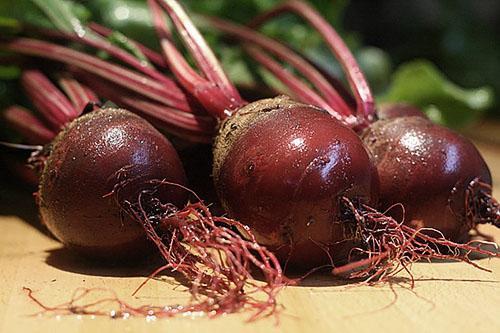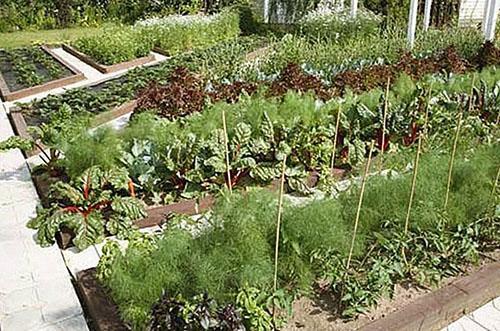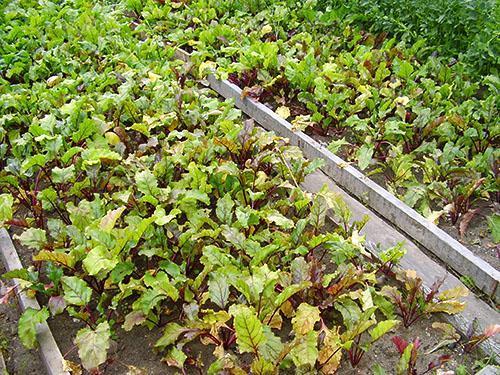Growing beets in the country in the open field
 It's amazing how much a summer resident needs to know in order to make his work happy, the products are clean of chemicals, and the harvest is sufficient to meet the annual need. One of the commonly grown vegetables is beetroot. It is impossible to imagine a vegetable garden without a beet bed. But not all summer residents succeed in it. There are subtleties in growing beets in the country that you need to know in order to get a tasty root crop with good preservation.
It's amazing how much a summer resident needs to know in order to make his work happy, the products are clean of chemicals, and the harvest is sufficient to meet the annual need. One of the commonly grown vegetables is beetroot. It is impossible to imagine a vegetable garden without a beet bed. But not all summer residents succeed in it. There are subtleties in growing beets in the country that you need to know in order to get a tasty root crop with good preservation.
Beet agricultural technology

- selection of seeds and their preparation for sowing;
- placement of the root crop;
- sowing and caring for seedlings;
- growing root crops;
- pest control;
- harvesting and its safety.

When choosing a place for a garden bed, you need to know that the place should be sunny, the land is loose and fertile. The main condition for obtaining good plants when growing beets in the open field is a rare planting with a distance in a row of at least 25 cm and between root crops at least 10 cm. The more, the better. In the cramped conditions of six acres, there are few such places, and if you also take into account that crop rotation must be observed, the choice of location is difficult. There are two exits, sowing on a narrow ridge along the Meatlider or along the sides of beds with other crops.
Beets are self-poisoning crops. It is impossible to plant beets in the same place next year, the yield will be significantly lower than for other predecessors.
Depending on the sowing time and region, beet varieties are selected. For autumn planting, you can take the Podzimnyaya A-474 variety. In order to obtain cylindrical fruits, there is a Cylinder. There are successful varieties - Gribovskaya, Egyptian, Pablo and others. When choosing seeds, you need to pay attention to their color. If the seeds have an uncharacteristic color, then they are already prepared for sowing.
Sowing beets and caring for young plants
 Simple seeds are multi-seed fruit in one package. In this case, it is necessary to process the seed in any growth stimulator and leave it raw for pecking for a day. Seeds are sown to a depth of 2 cm with a distance of 5 cm. When seeds germinate, leave only a strong seedling in the nest. In the future, as the beets are grown in the country, they are repeatedly thinned out for eating vitamin greens.
Simple seeds are multi-seed fruit in one package. In this case, it is necessary to process the seed in any growth stimulator and leave it raw for pecking for a day. Seeds are sown to a depth of 2 cm with a distance of 5 cm. When seeds germinate, leave only a strong seedling in the nest. In the future, as the beets are grown in the country, they are repeatedly thinned out for eating vitamin greens.
 Soil preparation for sowing begins in autumn. The future place is well filled with compost, superphosphate and potassium chloride. Compost is added to the garden bed. It will be useful to shed the sowing site with a 3% solution of copper sulfate in the fall. This will kill the weed spores while providing the soil with the copper that the beets need.
Soil preparation for sowing begins in autumn. The future place is well filled with compost, superphosphate and potassium chloride. Compost is added to the garden bed. It will be useful to shed the sowing site with a 3% solution of copper sulfate in the fall. This will kill the weed spores while providing the soil with the copper that the beets need.
Podzimny sowing is carried out in November, when the ground has already frozen over pre-prepared grooves. Root vegetables will need to be used as early greens. Winter crops are not suitable for storage. For winter storage, beets are sown at the end of May and later. In the warmed-up ground, the root crop develops well and quickly gains leaf mass. Often, summer residents planted beet seedlings in a permanent place. This method allows you to get products earlier.
 Particular attention is paid to the first stage of growth when growing and caring for beets.Thinning seedlings or caring for weak plants planted in seedlings is a crucial period. It is at this moment that pests and diseases can attack the plant. Therefore, the seedlings must be watered, showered ash or deterrent powders.
Particular attention is paid to the first stage of growth when growing and caring for beets.Thinning seedlings or caring for weak plants planted in seedlings is a crucial period. It is at this moment that pests and diseases can attack the plant. Therefore, the seedlings must be watered, showered ash or deterrent powders.
During this period, microbiological preparations should not be used. The root system of cultivated plants is still injured and should not be affected by bacteria. Therefore, within two weeks, if necessary, use chemicals. If drastic measures are preferable, then ordinary insecticides are used against insects during their mass appearance, and against fungal diseases Oxyhom or Fitosporin in permitted doses.
Formation of a rosette and root crop
 In order for the plant to develop faster, at the very beginning, after thinning, nitrogen fertilization is given. A tablespoon of urea is diluted in 10 liters of water and fertilizing is done on wet ground. After that, the plants are carefully loosened and weeded without damaging the root system.
In order for the plant to develop faster, at the very beginning, after thinning, nitrogen fertilization is given. A tablespoon of urea is diluted in 10 liters of water and fertilizing is done on wet ground. After that, the plants are carefully loosened and weeded without damaging the root system.
The amount of precipitation will tell you how often you water your beets outdoors. In any case, beets need one or two deep watering during development. The rest of the watering of the soil will maintain moisture. It is impossible to overdry the soil. Root vegetables may become tough or crack. But in the last three weeks before harvesting, there is no need to water and feed the beets.
When a plant is forming, it needs several additional feeding. When the plant is gaining a rosette, foliar feeding with micronutrient fertilizers and boric acid will be beneficial and the same after two weeks. Twice a season, you need to water the plants with salty water, dissolving a teaspoon of salt in a bucket of water. When filling a root crop the size of a walnut, use Agricola-4 fertilizer or potash and superphosphate fertilizers... Nitrogen accumulates in beets, impairs its storage and taste, therefore it is not used when pouring.
Boron and salt are essential for the development of the root crop. A native of the Mediterranean, beets love the salt crystals brought in by the sea air. Salt will add sweetness to the beets, and boron will protect the root crop from black ulcers of phomosis.
 The plant rises above the ground during filling. Do I need to huddle beets? Unlike carrots and potatoes, the root crop does not accumulate solanine from the action of light, does not change its taste. Therefore, it is not necessary to spud the beets. When to harvest beets depends on the weather. Roots protruding from the ground should be removed before frost or covered on cold nights.
The plant rises above the ground during filling. Do I need to huddle beets? Unlike carrots and potatoes, the root crop does not accumulate solanine from the action of light, does not change its taste. Therefore, it is not necessary to spud the beets. When to harvest beets depends on the weather. Roots protruding from the ground should be removed before frost or covered on cold nights.
Harvest
 Beets are harvested in clear dry weather. Experienced gardeners do not recommend cutting the tops with a knife. The reason is that the wounds do not dry out for a long time, and moisture leaves the root crop, which it needs so much during storage. How to properly harvest beets the video shows in detail. The main thing is to injure the skin of the product intended for storage. Root crops should be well dried in the shade, cleaned up the remnants of the earth and lowered into the cellar. Beets are stored in sand, in a dry box or pit.
Beets are harvested in clear dry weather. Experienced gardeners do not recommend cutting the tops with a knife. The reason is that the wounds do not dry out for a long time, and moisture leaves the root crop, which it needs so much during storage. How to properly harvest beets the video shows in detail. The main thing is to injure the skin of the product intended for storage. Root crops should be well dried in the shade, cleaned up the remnants of the earth and lowered into the cellar. Beets are stored in sand, in a dry box or pit.